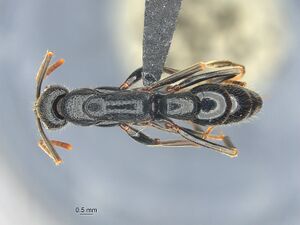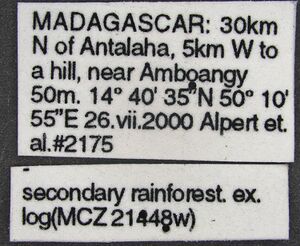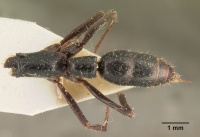Leptogenys acutirostris
| Leptogenys acutirostris | |
|---|---|

| |
| Scientific classification | |
| Kingdom: | Animalia |
| Phylum: | Arthropoda |
| Class: | Insecta |
| Order: | Hymenoptera |
| Family: | Formicidae |
| Subfamily: | Ponerinae |
| Tribe: | Ponerini |
| Genus: | Leptogenys |
| Species group: | saussurei |
| Species: | L. acutirostris |
| Binomial name | |
| Leptogenys acutirostris Santschi, 1912 | |
Leptogenys acutirostris has been found foraging on the forest floor and in leaf litter. Generally nests in rotten logs.
Identification
A member of the saussurei species group. Rakotonirina and Fisher (2014) - Worker. Mandible elongate and robust, capable of closing tightly against clypeus; anterior clypeal margin medially projecting into triangular lobe; clypeus with sharp edge laterally and bordered with lamella anteriorly. Eye large, diameter markedly greater than maximum width of antennal scape. Dorsum of head and mesosoma distinctly sculptured; with mesosoma in dorsal view, metanotal groove distinctly visible. In dorsal view, posterior margin of petiolar node straight not medially emarginate; in profile posterolateral margin without small tooth, but blunt angle.
Leptogenys acutirostris is very similar to Leptogenys saussurei and Leptogenys lohahela due to the presence of a metanotal groove, but the excised posterior margin of the petiolar node of L. saussurei renders it distinguishable from L. acutirostris. Leptogeenys acutirostris can be separated from Leptogenys lohahela by its larger size and the presence of a blunt angle on the posterolateral margin of the node. In L. lohahela, body size is smaller and a sharp denticle is present on the posterolateral margin of the petiolar node.
Keys including this Species
Distribution
Endemic to Madagascar, Leptogenys acutirostris is found in the lowland rainforest in the northeast of the island. Its range is between the PN Marojejy in the north and RS Ambatovaky in the South.
Distribution based on Regional Taxon Lists
Malagasy Region: Madagascar (type locality).
Distribution based on AntMaps
Distribution based on AntWeb specimens
Check data from AntWeb
Countries Occupied
| Number of countries occupied by this species based on AntWiki Regional Taxon Lists. In general, fewer countries occupied indicates a narrower range, while more countries indicates a more widespread species. |

|
Estimated Abundance
| Relative abundance based on number of AntMaps records per species (this species within the purple bar). Fewer records (to the left) indicates a less abundant/encountered species while more records (to the right) indicates more abundant/encountered species. |

|
Biology
|
Castes
Worker
   
| |
| . | Owned by Museum of Comparative Zoology. |
Images from AntWeb
 
| |
| Holotype of Leptogenys acutirostris. Worker. Specimen code casent0101130. Photographer April Nobile, uploaded by California Academy of Sciences. | Owned by NHMB, Basel, Switzerland. |
Nomenclature
The following information is derived from Barry Bolton's Online Catalogue of the Ants of the World.
- acutirostris. Leptogenys saussurei st. acutirostris Santschi, 1912b: 150 (w.) MADAGASCAR. Raised to species: Bolton, 1975a: 297.
Description
Worker
Rakotonirina and Fisher (2014) - (9 specimens). HW: 1.75–1.92, HL: 2.31–2.85, CI: 67–78, SL: 2.24–2.42, SI: 122–130, PW: 1.50–1.62, WL: 3.68–3.98, PNH: 1.29–1.44, PNL: 1.21–1.34, PNW: 1.07–1.23, DNI: 85–93, LNI: 104–111.
Head rectangular, lateral border slightly convex at level of eyes. Clypeus with large triangular median lobe, bordered with semi-translucent lamella, not bidentate anteriorly; lateral edge continuous and sharp. Translucent lamella on mandibular inner margin forming two close preapical teeth or blunt angles before reaching more distant, sharp apical tooth. In profile, mesopleural sulcus indistinct. With mesosoma in dorsal view, metanotal groove distinctly visible. In dorsal view, petiolar node elongate, posterior margin straight, not medially excised; in profile posterior margin without small teeth at mid-height, but with blunt angle. Head dorsum in front of level of anterior margin of eye longitudinally rugose, but densely punctate between level of anterior and posterior of ocular margin; posteriorly punctures become larger and scattered, spaces between them smooth. Mandible with fine longitudinal striation near base and sparsely punctuate towards apex. Mesosoma and petiolar node with interspersed punctures, the space between them are smooth and shining; sides may be faintly striate or reticulate-rugose. Upper level of propodeal declivity generally smooth and with transeverse striation or rugulation at level of propodeal lobe. Gaster generally smooth. Color with bluish reflection.
Type Material
Rakotonirina and Fisher (2014) - Holotype worker, Madagascar (Le Moult) (Naturhistorisches Museum, Basel) AntWeb specimen code: CASENT0101130 [examined].
References
- Bolton, B. 1975a. A revision of the ant genus Leptogenys Roger (Hymenoptera: Formicidae) in the Ethiopian region with a review of the Malagasy species. Bull. Br. Mus. (Nat. Hist.) Entomol. 31: 235-305 (page 297, Raised to species)
- Rakotonirina, J.C. & Fisher, B.L. 2014. Revision of the Malagasy ponerine ants of the genus Leptogenys Roger (Hymenoptera: Formicidae). Zootaxa 3836, 1-163.
- Santschi, F. 1912b. Fourmis d'Afrique et de Madagascar. Ann. Soc. Entomol. Belg. 56: 150-167 (page 150, worker described)
References based on Global Ant Biodiversity Informatics
- Bolton B. 1975. A revision of the ant genus Leptogenys Roger (Hymenoptera: Formicidae) in the Ethiopian region with a review of the Malagasy species. Bulletin of the British Museum (Natural History). Entomology 31: 235-305.
- Fisher B. L. 1997. Biogeography and ecology of the ant fauna of Madagascar (Hymenoptera: Formicidae). Journal of Natural History 31: 269-302.
- Fisher B. L. 2003. Formicidae, ants. Pp. 811-819 in: Goodman, S. M.; Benstead, J. P. (eds.) 2003. The natural history of Madagascar. Chicago: University of Chicago Press, xxi + 1709 pp.
- Rakotonirina J. C., and B. L. Fisher. 2014. Revision of the Malagasy ponerine ants of the genus Leptogenys Roger (Hymenoptera: Formicidae). Zootaxa 3836 (1): 001163.
- Santschi F. 1912. Fourmis d'Afrique et de Madagascar. Annales de la Société Entomologique de Belgique 56: 150-167.
- Wheeler W. M. 1922. Ants of the American Museum Congo expedition. A contribution to the myrmecology of Africa. IX. A synonymic list of the ants of the Malagasy region. Bulletin of the American Museum of Natural History 45: 1005-1055

